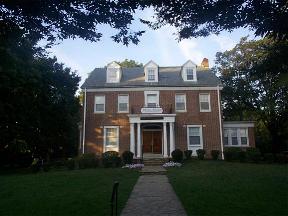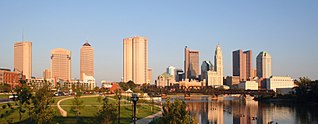Related Research Articles
Jews in Philadelphia can trace their history back to Colonial America. Jews have lived in Philadelphia since the arrival of William Penn in 1682.
The history of the Jews in Pennsylvania dates back to Colonial America.

The history of the Jews in Pittsburgh dates back to the mid-19th century. In 2002, Jewish households represented 3.8% of households in Allegheny County, Pennsylvania. As of 2017, there were an estimated 50,000 Jews in the Greater Pittsburgh area. In 2012, Pittsburgh's Jewish community celebrated its 100th year of federated giving through the Jewish Federation of Greater Pittsburgh. The city's Jewish federation is one of the oldest in the country, marking the deep historical roots of Jews in Pittsburgh.
The history of Jews in Australia traces the history of Australian Jews from the British settlement of Australia commencing in 1788. Though Europeans had visited Australia before 1788, there is no evidence of any Jewish sailors among the crew. The first Jews known to have come to Australia came as convicts transported to Botany Bay in 1788 aboard the First Fleet that established the first European settlement on the continent, on the site of present-day Sydney.

Congregation B'nai Israel is a Jewish synagogue located in Galveston, Texas, USA. Organized by German Jewish immigrants in 1868, it is the oldest Jewish Reform congregation and the second chartered Jewish congregation in the state.
Jewish Texans have been a part of the history of Texas since the first European explorers arrived in the region in the 16th century. In 1990, there were around 108,000 adherents to Judaism in Texas. More recent estimates place the number at around 120,000.
The history of the Jews in Jamaica predominantly dates back to migrants from Spain and Portugal. Starting in 1509, many Jews began fleeing from Spain because of the persecution of the Holy Inquisition. When the English captured Jamaica from Spain in 1655, the Jews who were living as conversos began to practice Judaism openly. By 1611, the Island of Jamaica had reached an estimated population of 1,500 people. An estimated 75 of those people were described as "foreigners," which may have included some Portuguese Jews. Still, many Jews faced persecution from English merchants.
The history of the Jews in Vancouver in British Columbia, Canada has been noted since the mid-19th century.
Toronto's Jewish community is the most populous and one of the oldest in the country, forming a significant part of the history of the Jews in Canada. It numbered about 240,000 in the 2001 census, having overtaken Montreal in the 1970s. As of 2011, the Greater Toronto Area is home to 188,710 Jews. The community in Toronto is composed of many different Jewish ethnic divisions, reflecting waves of immigration which started in the early 19th century. Canada's largest city is a centre of Jewish Canadian culture, and Toronto's Jews have played an important role in the development of the city.
Jews have been living in Maine, a state in the northeastern United States, for 200 years, with significant Jewish communities in Bangor as early as the 1840s and in Portland since the 1880s. The arrival of Susman Abrams in 1785 was followed by a history of immigration and settlement that parallels the history of Jewish immigration to the United States.

The history of the Jews in the Democratic Republic of the Congo can be traced back to 1907, when the first Jewish immigrants began to arrive in the country. The current Jewish Congolese population is mostly of Sephardi background.
The history of the Jews in Curaçao can be traced back to the mid-17th century, when the first Jewish immigrants began to arrive. The first Jews in Curaçao were Sephardi Jewish immigrants from the Netherlands, Portugal, and Spain. These immigrants founded Congregation Mikvé Israel-Emanuel, the oldest continuously used synagogue in the Americas. The first Jew to settle in Curaçao was a Dutch-Jewish interpreter named Samuel Cohen, who arrived on board a Dutch fleet in 1634. By the mid-1700s, the community was the most prosperous in the Americas and many of the Jewish communities in Latin America, primarily in Colombia and Venezuela, resulted from the influx of Curaçaoan Jews.

The Jewish community of Houston, Texas has grown and thrived since the 1800s. As of 2008 Jews lived in many Houston neighborhoods and Meyerland is the center of the Jewish community in the area.

Few Jews arrived in Baltimore, Maryland, in its early years. As an immigrant port of entry and border town between North and South and as a manufacturing center in its own right, Baltimore has been well-positioned to reflect developments in American Jewish life. Yet, the Jewish community of Baltimore has maintained its own distinctive character as well.
At the end of the 20th century there were a total of 270,000 Jews in the Chicago area, with 30% in the city limits. In 1995, over 80% of the suburban Jewish population lived in the northern and northwestern suburbs of Chicago. At this time, West Rogers Park was the largest Jewish community within the city of Chicago. However, the Jewish population within the city had been declining and tended to be older and more well-educated than the Chicago average. The Jewish immigrants to Chicago came from many different countries, with the most common being Eastern Europe and Germany.

Jews in Los Angeles comprise approximately 17.5 percent of the city's population, and 7% of the county's population, making the Jewish community the largest in the world outside of New York City and Israel. As of 2015, over 700,000 Jews live in the County of Los Angeles, and 1.232 million Jews live in California overall. Jews have immigrated to Los Angeles since it was part of the Mexican state of Alta California, but most notably beginning at the end of the 19th century to the present day. The Jewish population rose from about 2,500 in 1900 to at least 700,000 in 2015. The large Jewish population has led to a significant impact on the culture of Los Angeles. The Jewish population of Los Angeles has seen a sharp increase in the past several decades, owing to internal migration of Jews from the East Coast, as well as immigration from Israel, France, the former Soviet Union, the UK, South Africa, and Latin America, and also due to the high birth rate of the Hasidic and Orthodox communities who comprise about 10% of the community's population.

The Jewish community of the Greater Cleveland area comprises a significant ethnoreligious population of the U.S. State of Ohio. It began in 1839 by immigrants from Bavaria and its size has significantly grown in the decades since then. In the early 21st century, Ohio's census data reported over 150,000 Jews, with the Cleveland area being home to more than 50% of this population. As of 2018, Greater Cleveland is the 23rd largest Jewish community in the United States. As of 2023, the Cleveland Jewish Community is estimated to be about 100,000 people.

The Jewish community of Greater Columbus has made up a small but noteworthy part of the region since the arrival of Jews in 1840. The community has gone through periods of growth, especially in the last quarter of the 20th century. Today, the well-established community includes schools, temples, elder care facilities, kosher food services, ritual baths, social clubs, community religious learning centers and other organizations and has a population of approximately 25,500, as of the most recent 2013 study. It is the 43rd largest Jewish community in the United States and the third largest in Ohio, trailing Cleveland and Cincinnati.
The city of Frederick, Maryland is home to a small but growing Jewish community. With roots dating to the colonial era, Frederick's Jewish community is home to three synagogues, a Hebrew school, and a Jewish community center.
The history of Jews in New Jersey started with the arrival of Dutch and English traders and settlers in the late 1600s. According to the Berman Jewish DataBank's 2019 survey, New Jersey is the state with the fourth highest total population of Jews at 545,450, and is also the state with the third highest percent of Jews at 6.1%. This means that New Jersey is home to 7.8% of the American Jewish population.
References
- 1 2 Avner, Jane. "Jews". Encyclopedia of Milwaukee. Retrieved 1 August 2022.
- 1 2 3 4 Cohen, Sheila Terman (25 September 2019). "What Happened To Wisconsin's Once-Thriving Smaller Jewish Communities?". WisContext. Retrieved 1 August 2022.
- ↑ Sheskin, Ira M.; Dashefsky, Arnold (2018). "United States Jewish Population, 2017". American Jewish Year Book 2017: The Annual Record of the North American Jewish Communities. American Jewish Year Book. 117: 179–284. doi:10.1007/978-3-319-70663-4_5. ISBN 978-3-319-70662-7 . Retrieved 1 August 2022.
- 1 2 3 4 Swichkow, Louis J. (1957). "The Jewish Community of Milwaukee, Wisconsin, 1860-1870". Publications of the American Jewish Historical Society. 47 (1): 34–58. ISSN 0146-5511. JSTOR 43059005 . Retrieved 2 August 2022.
- 1 2 3 Hintz, Martin (2005). Jewish Milwaukee. Charleston, SC: Arcadia. ISBN 9780738539720.
- 1 2 3 Cohen, Sheila Terman (2016). Jews in Wisconsin. Madison: Wisconsin Historical Society Press. ISBN 9780870207457 . Retrieved 2 August 2022.
- 1 2 3 4 Zaret, Melvin S. (2007). "Milwaukee". Encyclopaedia Judaica (2nd ed.). Macmillan Reference USA. pp. 261–263. Retrieved 1 August 2022.
- 1 2 3 4 "Jews in Wisconsin". Wisconsin Historical Society. 3 August 2012. Retrieved 1 August 2022.
- ↑ Byers, Steve (9 October 2019). "The cultural impact of "Americanization" on Milwaukee's original Jewish immigrant population". The Milwaukee Independent. Milwaukee Independent. Retrieved 1 August 2022.
- ↑ "About Wisconsin Jewish Chronicle". www.jewishchronicle.org. Retrieved 1 August 2022.
- ↑ "25th Annual Milwaukee Jewish Film Festival". JCC Milwaukee. Harry & Rose Samson Family Jewish Community Center. 29 August 2022. Retrieved 31 October 2022.
- ↑ "About Jewish Museum Milwaukee". jewishmuseummilwaukee.org. Retrieved 1 August 2022.
- ↑ Cohen, Leon (29 April 2015). "Revised community study finds fewer Milwaukee Jews". www.jewishchronicle.org. The Wisconsin Jewish Chronicle. Retrieved 1 August 2022.
- ↑ Miller, Ron; Kotler-Berkowitz, Laurence; Percy, Stephen. "2011 Jewish Study Greater Milwaukee (Revised March 2015)". www.jewishdatabank.org. Berman Jewish Databank. Retrieved 1 August 2022.
- ↑ "About". HILLEL MILWAUKEE. Retrieved 2 August 2022.
- ↑ "Chabad at UW-Milwaukee". Chabad-Lubavitch of Wisconsin. Chabad.org. Retrieved 2 August 2022.
- ↑ "The Sam and Helen Stahl Center for Jewish Studies - UW-Milwaukee". The Sam and Helen Stahl Center for Jewish Studies. University of Wisconsin-Milwaukee. Retrieved 2 August 2022.
- ↑ "Jewish American Heritage Month". VISIT Milwaukee. Retrieved 1 August 2022.